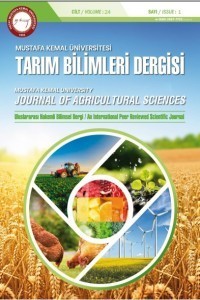Erken gelişme döneminde yapraktan bor uygulamasının mısırın hasıl verimi ve kalitesi üzerine etkileri
bor, adf, ndf, silaj verimi
Effects of foliar boron fertilization at early vegetative stages on silage yield and quality parameters of maize
Boron, maize, NDF and ADF, silage yield,
___
- Ahmad W, Zia MH, Malhi SS, Niaz SS (2014) Boron deficiency in soil and crops: A Review. Aveilable online: http://www.intechopen.com/books/crop-plant/boron/deficiency-in-soil-and-crops-a-e-review (Accessed on 4June 2014)
- Anoymous (2016)Turkısh statistical institute www.tuik.gov.tr. Accessed on 4 June 2017.
- Aref F (2011) The effect of boron and zinc application on concentration and uptake of nitrogen, phosphorous and potassium in corn grain. Indian Journal and Technology, 4(7):785-791.
- Atış İ, Konuşkan Ö, Gözübenli H, Yılmaz Ş, Can E, Çeliktaş N (2013) Determination of silage yield potential of some actual maize cultivars as main crop in Amik Plain conditions. Turkey 10. Field Crops Congress, 10-13 September 2013, Konya, Volume 3, p: 649-653.
- Chahine M (2009) Target values for corn silage. Idoha Alfalfa and Forage Conference Proceedings p.1-5. 3-5 Feb.2009.
- Filya I (2004) Nutritive value and aerobic stability of whole maize silage harvested at four stages of maturity. Anim. Feed. Sci. Tech., 116: 141–150.
- Güneş A, Ataoğlu N, Esringü A, Uzun O, Ata S, Turan M (2011) Yield and chamical composition of corn (Zea mays L.) as affected by boron management. International Journol of Plant, Animal and Enviromental Science, 1(1):42-53.
- Gözübenli H, Konuskan Ö, Aktürk H (2010) Detemination of grain yield yield-related traits of mazize hybrids sown at different plantig times and plant densities. Journal of Agriculture Faculty of Mustafa Kemal University, 15(1):1-10.
- Horuz A, Özcan C (2017) Effects of boron application to corn plant on yield and boron content in the calcerous soil. Journal of Boron 2(1);37-42
- Ileri, O, Çarpıcı BE, Erbeyi B, Avcı S, Koc A (2018) Effect of sowing methods on silage yield and quality of some corn cultivars grown in second crop season under irrigated condıtıon of Central Anatolia, Turkey. Turk J Fiel Crops., 23(1):72-79.
- Johnson L, Harrison JH, Davidson D, Mahanna WC, Shinners K, Linder D, (2000) Com silage management: effect of maturity, inoculation, and mechanical processing on pack density and aerobic stability. J. Dairy Sci., 85:434–444.
- Kaur G, Nelson KA (2015) Effect of foliar boron fertilization of fine textured soils on corn yield. Agronomy., 5(1):1-18.
- Keskin B, Temel S, Eren B (2017) Determination of yield and plant characteristics of some silage corn varieties. Igdır Univ. J. Inst. Sci. and Tech., 7(1): 347-351.
- Konuskan Ö, Atış İ, Gözübenli H (2015) Yield and yield components of some dent maize genotypes grown as main crop in amik plain conditions. Journal of Agriculture Faculty of Mustafa Kemal University, 20(2): 1-6.
- Konuskan O, Konuskan Bozdogan D, Lavei CM (2017). Effect of foliar fertilization on chemical properties and fatty acid composition of corn (Zea mays L). Revista de Chemie, 68(9):2073-2075.
- Konuskan O (2018) Aplication of boron at early vegatative stage improves the quality as well as productivity of maize (Zea mays L.) in Mediterrenean Enviroment. Fresenius Enviromental Bulletin, 27(3):1756-1763.
- Marschner H (1995) Mineral Nutrition of Higher Plants (2nd Ed.). London: Academic Press. pp.889
- Nazlı MH, Halim RA, Abdullah AM, Hussin G, Samsudin AA (2019) Potential of four corn varieties at different harvest stages for silage production in Malaysia. Asian- Australas J Animal Sci., 32 (2): 224-232.
- Nawaz S, Zammurad IA, Ansar M, Manaf A, Qayyum A, Sher A (2017) Agronomic efficiency and HCN content of sorghum cultivars as influenced by zinc and boron application under subtropical condition. Z Arznei-Gewurpfla, 22(4): 160-164.
- Nelson KA, Meinhardt CG (2011) Foliar boron and pyraclostrobin effects on corn yield. Agronomy Journal, 103(5):1352-1358.
- Shabaz MK, Ali H, Sajjad M, Shah SAN, Malook S (2015) Role of zinc nutrition in maize for growth and yield: An Overview. American-Eurasian J. Agric. & Environ. Sci. 15 (7): 1323-1330.
- Torun M (1999) Determination of suitable corn varieties for silage under Samsun Conditions. The Journal of Agricultural Faculty of Ondokuz Mayıs Univ 14(1): 19- 30.
- Van Soest PJ, Robertson JB. Lewis BA (1991) Methods for dietary fiber, neutral detergent fiber, and nonstarch polysaccharides in relation to animal nutrition. J. Dairy Sci. 74: 3583–3597.
- Wasaya A, Shabir MS, Hussain M, Ansar M, Aziz A, Hassan W, Ahmad I (2017) Foliar application of zinc and boron improvement the productivity and net returns of maize grown under rainfed conditions of Pothwar Plateau. Lournal of Soil Science and Plant Nutrition 17(1): 33-45.
- Yarnia M, Behrouzyar, EK, Khoii FR, Mogaddam M, Vishkaii MSS (2013) Effects of methanol and some micro-macronutrients foliar applications on maize (Zea mays L.) maternal plants on subsequent generation yield and reserved mineral nutrients of the seed. African Journal of Agricultural Research 8(7): 619-628.
- Yılmaz Ş, Gözübenli H, Can E, Atış İ (2003) Adaptation and silage yield of some maize (Zea mays L.) lines in Amik Plain conditions. Turkey 5. Field crops Congress, 13-17 October 2003, Diyarbakır, pp: 341-345.
- Yayın Aralığı: Yılda 3 Sayı
- Başlangıç: 1996
- Yayıncı: Hatay Mustafa Kemal Üniversitesi
Isparta ve Karaman illerinde elma üretim maliyetinin karşılaştırılması
Serkan URANBEY, Güray AKDOGAN, Hussein Abdullah Ahmed AHMED, Mikail CALİSKAN
Sinop Karasu Çayı fizikokimyasal özellikleri ve mikrobiyolojik kirliliğinin araştırılması
Ömer KONUŞKAN, İbrahim ATIŞ, Hüseyin GÖZÜBENLİ
Mustafa KIZILSIMSEK, Eylul Nezahat SÜREN
Aysel ARSLAN, Yurtsever SOYSAL, Muharrem KESKİN
